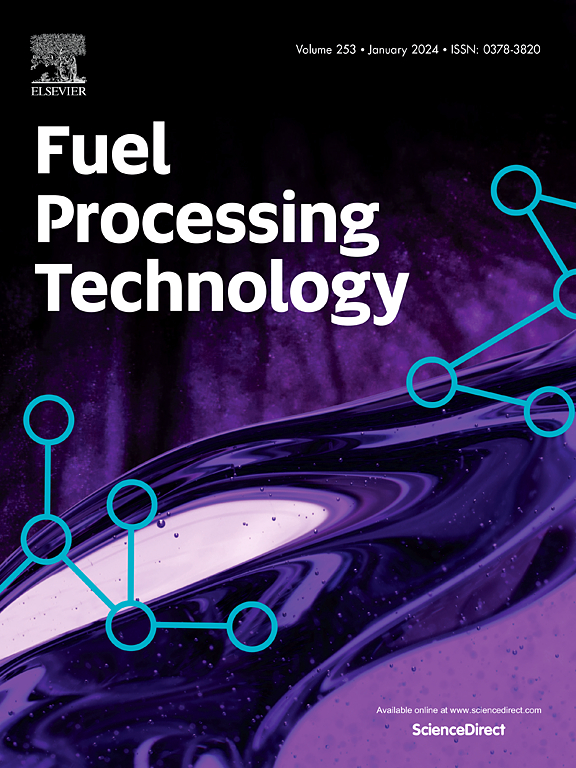Hydroisomerization of n-dodecane on ZSM-48 with acid distribution modulation for high diffusion performance
IF 7.7
2区 工程技术
Q1 CHEMISTRY, APPLIED
引用次数: 0
Abstract
In this paper, a one-dimensional ten-membered ring microporous molecular sieve ZSM-48 is employed as a model catalyst, with the number and positional distribution of acid sites in ZSM-48 molecular sieve adjusted by regulating the temperature of templating agent exfoliation. XRD, FT-IR, SEM, TG, NH3-TPD, N2 adsorption-desorption, and the zero-length column (ZLC) method are used for characterization and analysis. The decrease in the distribution depth of acid sites within the microporous channels of ZSM-48 will not only significantly affects the hydroisomerization performance of n-dodecane (resulting in a final yield of isododecane of more than 80 %) but also influences the yield ratio of multi-branched and mono-branched isomers. After the conversion is stabilized, the yield ratio of multi-branched to mono-branched isomers for Z-48-350 is 1.4 to 2.1 times higher than that for Z-48-550. Furthermore, acid site distribution depth profoundly influences reactant diffusion, with Z-48-120 exhibiting a 115 % higher effective diffusion constant than Z-48-550 at 140 °C. Shortening the distribution depth of acid sites in the micropores does not significantly change the product distribution of n-dodecane monomethyl isomers but markedly suppresses the cracking reaction due to reduced diffusion limitation of olefinic intermediates. This enables efficient and selective hydroisomerization of long-chain n-alkanes.
正十二烷在ZSM-48上的加氢异构化与酸分布调制以获得高扩散性能
本文以一维十元环微孔分子筛 ZSM-48 为模型催化剂,通过调节模板剂剥离温度来调整 ZSM-48 分子筛中酸位点的数量和位置分布。采用 XRD、FT-IR、SEM、TG、NH3-TPD、N2 吸附-解吸和零长柱 (ZLC) 法进行表征和分析。酸位点在 ZSM-48 微孔通道内分布深度的减少不仅会显著影响正十二烷的加氢异构化性能(使异十二烷的最终产率超过 80%),还会影响多支链异构体和单支链异构体的产率比。转化稳定后,Z-48-350 的多支链异构体与单支链异构体的产率比 Z-48-550 高 1.4 至 2.1 倍。此外,酸性位点的分布深度对反应物的扩散影响很大,在 140 °C 时,Z-48-120 的有效扩散常数比 Z-48-550 高 115%。缩短微孔中酸性位点的分布深度不会显著改变正十二烷单甲基异构体的产物分布,但由于烯烃中间体的扩散限制减少,裂解反应会明显受到抑制。这使得长链正构烷烃的加氢异构化变得高效且具有选择性。
本文章由计算机程序翻译,如有差异,请以英文原文为准。
求助全文
约1分钟内获得全文
求助全文
来源期刊

Fuel Processing Technology
工程技术-工程:化工
CiteScore
13.20
自引率
9.30%
发文量
398
审稿时长
26 days
期刊介绍:
Fuel Processing Technology (FPT) deals with the scientific and technological aspects of converting fossil and renewable resources to clean fuels, value-added chemicals, fuel-related advanced carbon materials and by-products. In addition to the traditional non-nuclear fossil fuels, biomass and wastes, papers on the integration of renewables such as solar and wind energy and energy storage into the fuel processing processes, as well as papers on the production and conversion of non-carbon-containing fuels such as hydrogen and ammonia, are also welcome. While chemical conversion is emphasized, papers on advanced physical conversion processes are also considered for publication in FPT. Papers on the fundamental aspects of fuel structure and properties will also be considered.
 求助内容:
求助内容: 应助结果提醒方式:
应助结果提醒方式:


